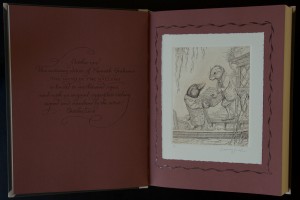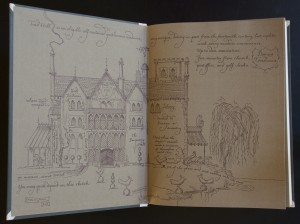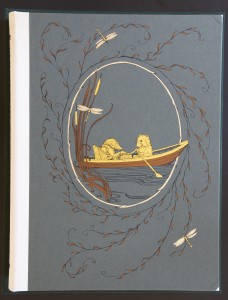 I’m not sure how many times I read The Wind in the Willows as a kid but I’m certain that my childhood reading contributes to the whole book experience that is the Folio Society’s edition of this classic. It’s entirely possible that if I had come to this story at this point in my life for the first time, that I might not find it as enjoyable as I do. Some people might have obtained this edition just for the art of Charles van Sandwyk or for the superb workmanship of the other aspects of the book. Needless to say, the book I read as a kid was not a fine edition by any means. But I do recall enchanting illustrations, and I especially remember liking the map of the area where all the adventures occur. I’ve heard that the book is still in our family but have not had a chance to visit my brother to see if it is the one I remember so fondly. I would be interested to compare those illustrations with the ones in this beautiful Folio Society edition.
I’m not sure how many times I read The Wind in the Willows as a kid but I’m certain that my childhood reading contributes to the whole book experience that is the Folio Society’s edition of this classic. It’s entirely possible that if I had come to this story at this point in my life for the first time, that I might not find it as enjoyable as I do. Some people might have obtained this edition just for the art of Charles van Sandwyk or for the superb workmanship of the other aspects of the book. Needless to say, the book I read as a kid was not a fine edition by any means. But I do recall enchanting illustrations, and I especially remember liking the map of the area where all the adventures occur. I’ve heard that the book is still in our family but have not had a chance to visit my brother to see if it is the one I remember so fondly. I would be interested to compare those illustrations with the ones in this beautiful Folio Society edition.
I know that the Limited Editions Club did an edition with the illustrations of Arthur Rackham back in 1940. I’d love to get a hold of this edition and see the real illustrations. I have the Easton Press reprint and have to say I prefer the Charles van Sandwyk illustrations. But I’ve found that the EP reprints can be very different than the ones in the original LEC books, so I’ll reserve final judgment on them until I see them. I don’t believe that the Rackham illustrations are the ones I remember from my youth either, so that will be interesting to find out. I know that Ernest Shepard also illustrated the book and so his might be the ones from my childhood book.
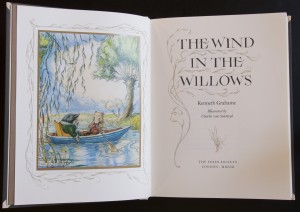 The Folio Society edition is hand bound in quarter vellum with paper sides illustrated by van Sandwyk and blocked in 22 karat gold. The color plates are tipped in with line drawing borders. The limitation number for the edition actually appears on the first color etching along with the artist’s signature. This might be the first time I am aware of the Folio Society doing a “signed” edition. The color plates are magnificent but I also really like the pen-and-ink drawings that appear throughout the text and as chapter heads and tails. The Folio Society like this design formula as they subsequently used it on the Rubáiyát and Gulliver’s Travels. Their members apparently like it as well as the Wind in the Willows and the Rubáiyát sold out quickly and I won’t be surprised if the recently published Swift does the same.
The Folio Society edition is hand bound in quarter vellum with paper sides illustrated by van Sandwyk and blocked in 22 karat gold. The color plates are tipped in with line drawing borders. The limitation number for the edition actually appears on the first color etching along with the artist’s signature. This might be the first time I am aware of the Folio Society doing a “signed” edition. The color plates are magnificent but I also really like the pen-and-ink drawings that appear throughout the text and as chapter heads and tails. The Folio Society like this design formula as they subsequently used it on the Rubáiyát and Gulliver’s Travels. Their members apparently like it as well as the Wind in the Willows and the Rubáiyát sold out quickly and I won’t be surprised if the recently published Swift does the same.
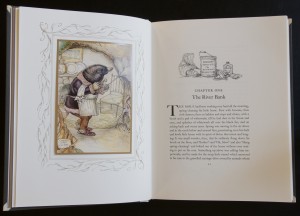 The primary paper used is nice Cordier Wove while the special limited edition etching is on an awesome Somerset velvet buff 100% cotton mould-made paper. The etching is mounted on a letterpress printed page using Hahnebühle Bugra Butten paper. These two papers blow the Cordier Wove paper away, so it would have been nice to see the whole edition printed this way. Letterpress throughout would have been great too, but obviously that would have pushed the cost up considerably. Nevertheless, it is a nicely balanced combination of papers, printing methods, illustrations and other features.
The primary paper used is nice Cordier Wove while the special limited edition etching is on an awesome Somerset velvet buff 100% cotton mould-made paper. The etching is mounted on a letterpress printed page using Hahnebühle Bugra Butten paper. These two papers blow the Cordier Wove paper away, so it would have been nice to see the whole edition printed this way. Letterpress throughout would have been great too, but obviously that would have pushed the cost up considerably. Nevertheless, it is a nicely balanced combination of papers, printing methods, illustrations and other features.
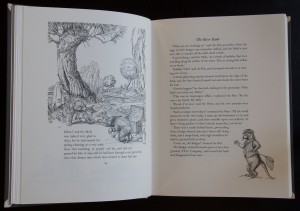 I’ve always loved literature that uses animals and/or non-humans for characters or subjects. It tends to get me out of the human-centric view of the world that every other species is there for our use and reinforces that all species have value. That may not be Grahame’s intention here as he spins his entertaining tale but his characters certainly are well developed and have their distinct personalities. Obviously the use of
I’ve always loved literature that uses animals and/or non-humans for characters or subjects. It tends to get me out of the human-centric view of the world that every other species is there for our use and reinforces that all species have value. That may not be Grahame’s intention here as he spins his entertaining tale but his characters certainly are well developed and have their distinct personalities. Obviously the use of 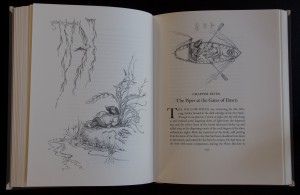 animals as speaking, feeling, thinking characters is very popular in children’s literature but it is not limited to that genre and resonates with adults as well. Especially when the animals exhibit traits and emotions that are complex and not just cute. The Wind in the Willow certainly transcends the genre of children’s literature.
animals as speaking, feeling, thinking characters is very popular in children’s literature but it is not limited to that genre and resonates with adults as well. Especially when the animals exhibit traits and emotions that are complex and not just cute. The Wind in the Willow certainly transcends the genre of children’s literature.
A. A. Milne summed it up nicely in the introduction (probably originally written for the Limited Editions Club) to the Easton Press Famous Editions reprint:
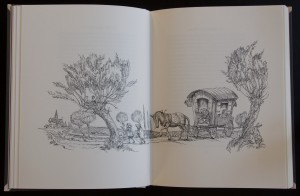 “One can argue over the merits of most books, and in arguing understand the point of view of one’s opponent. One may even come to the conclusion that possibly he is right after all. One does not argue about The Wind in the Willows. The young man gives it to the girl with whom he is in love, and if she does not like it, asks her to return his
“One can argue over the merits of most books, and in arguing understand the point of view of one’s opponent. One may even come to the conclusion that possibly he is right after all. One does not argue about The Wind in the Willows. The young man gives it to the girl with whom he is in love, and if she does not like it, asks her to return his 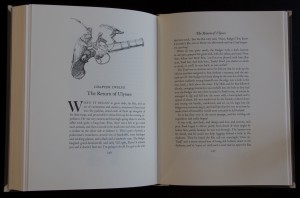 letters. The older man tries it on his nephew, and alters his will accordingly. The book is a test of character. We can’t criticize it, because it is criticizing us. As I wrote once: It is a Household Book; a book which everybody in the household loves, and quotes continually; a book which is read aloud to every new guest and is regarded as a touchstone of his worth. But I must give you one word of warning. When you sit down to it, don’t be so ridiculous as to suppose that you are sitting in judgment on my taste, or on the art of Kenneth Grahame. You are merely sitting in judgment on yourself. You may be worthy: I don’t know. But it is you who are on trial.”
letters. The older man tries it on his nephew, and alters his will accordingly. The book is a test of character. We can’t criticize it, because it is criticizing us. As I wrote once: It is a Household Book; a book which everybody in the household loves, and quotes continually; a book which is read aloud to every new guest and is regarded as a touchstone of his worth. But I must give you one word of warning. When you sit down to it, don’t be so ridiculous as to suppose that you are sitting in judgment on my taste, or on the art of Kenneth Grahame. You are merely sitting in judgment on yourself. You may be worthy: I don’t know. But it is you who are on trial.”
Availability: This edition was released in a limitation of 1000 and quickly sold out. Copies may be available occasionally on the second-hand market.

